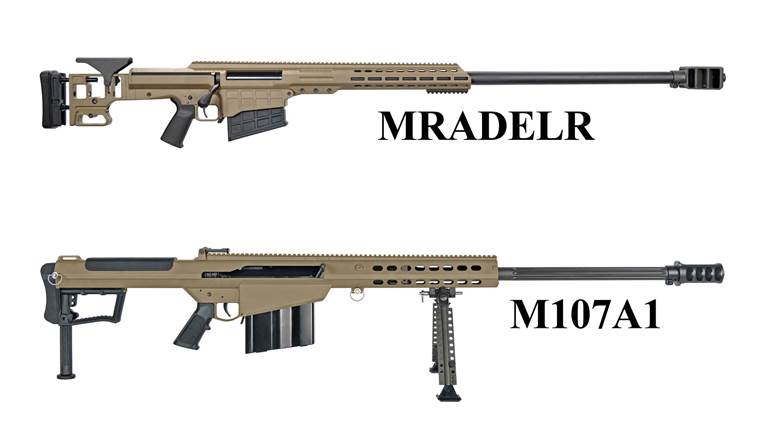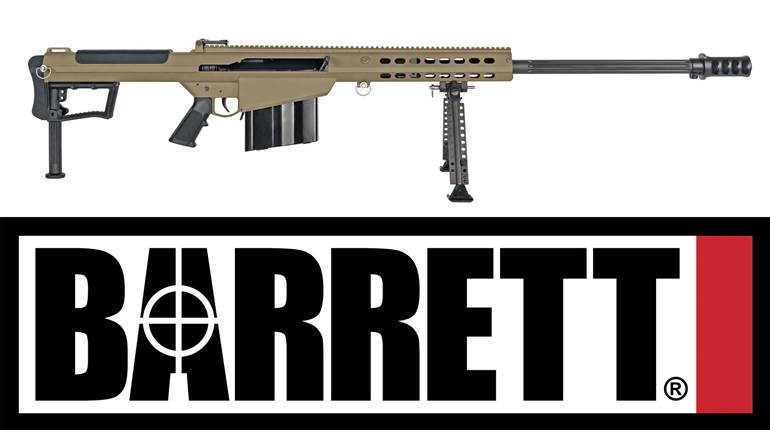
The M4-pattern carbine is inarguably today’s standard. For some, however, its 5.56x45 mm NATO chambering and direct gas-impingement system of operation are points of contention. Barrett Firearms Mfg., a company well-known for its fresh perspective on firearm designs, is offering an M4-style variant named the REC7 that strives to address these concerns.
The semi-automatic REC7, whose designation stands for “reliability-enhanced carbine,” not only chambers a larger cartridge than the M4 but also features a redesigned system of gas-piston operation. The carbine is chambered for the 6.8x43 mm SPC (Special Purpose Cartridge), a round that propels a 115-gr. projectile at roughly 2,500 f.p.s. from the muzzle. The overall length of the cartridge is nearly the same as that of a 5.56x45 mm NATO, so it is compatible with a standard-size lower receiver.
Interestingly, the REC7 is Barrett’s second AR-pattern rifle chambered for this cartridge, with its first being the M468. Although the 6.8 SPC-chambered M468 was well-received, the rifle employed the same direct gas-impingement system as the M4. The result was a system that jetted hot gases directly into the rifle’s receiver, leading to potential stoppages if regular maintenance and cleaning protocols were overlooked.
To enhance potential mechanical reliability, Barrett incorporated a short-stroke, piston-driven system that offers the potential for cleaner and cooler operation than one with direct gas-impingement.
The REC7 features forged 7075 aluminum upper and lower receivers that are hard-coat anodized a deep black. The upper receiver is a flat-top configuration with an integral strip of Picatinny rail. The chrome-lined barrel is 16-inches long and is fitted with an A2-style birdcage muzzle brake. A standard A2-style pistol grip and collapsible buttstock round out the package.
The free-floated aluminum fore-end is the excellent A.R.M.S. SIR (for Selective Integrated Rail) that features customizable strips of rail that can be positioned at the location of the user’s preference. The upper rail of the fore-end aligns with the REC7’s upper receiver to form a contiguous Picatinny rail along the rifle’s top. This strip of rail also aligns with a separate Picatinny rail on top of the REC7’s gas block.
Although the 6.8 SPC cartridge was designed to be used in standard AR lowers, conventional AR magazines are unsuitable. As a result, Barrett developed a rugged proprietary magazine for its 6.8 SPC rifles that differs in both dimensions and materials from that of a standard AR-pattern magazine. Manufactured from steel and featuring a steel follower, the REC7’s 30-round magazine is about one-inch longer overall and weighs 5 ounces more than a standard AR magazine.
The REC7’s most significant new element, its gas system, is a short-stroke gas piston designed in-house by Barrett. It rides above the barrel and is housed inside the REC7’s A.R.M.S. fore-end. The spring-loaded piston is a one-piece 17-4 stainless steel rod that weighs 3.5 ounces and is 12.25-inches long. Total forward and rearward movement of the piston is approximately one inch.
The gas system and fore-end are of mid-length dimensions, rather than the shorter standard carbine length, with the rifle’s gas block located roughly 9.5 inches forward of the front face of the upper receiver. This is two inches farther than that of a standard-length carbine gas system.
The gas block is a proprietary Barrett design that allows users to remove the gas piston easily for cleaning by simply rotating a spring-mounted plunger 180 degrees. Once rotated, the rifle’s gas regulator, piston and piston return spring can be pulled forward and through the gas block.
Adapting the AR design to work with a piston also necessitated modifications to the bolt carrier assembly, specifically where it interfaces with the rear of the piston rod. Rather than having a standard gas key on its bolt carrier that cups the open rear face of a gas tube, the top of the REC7’s 8620 steel bolt carrier assembly features an integral piston strike face. This reinforced part is impacted by the piston’s rearward one-inch of thrust during cycling, causing the action to open and the bolt carrier assembly to cycle rearward. The bolt of the REC7 is chrome-plated and free of gas rings.
The REC7 received for testing was visually impressive with evenly applied black anodizing on the upper and lower receivers and a matching manganese phosphated finish on the steel parts. All controls functioned positively and smoothly. Anyone familiar with the operation of a conventional AR would be right at home with the REC7, although its somewhat heavy weight of 7 pounds, 8 ounces, can be a bit noticeable compared to a 5.56x45 mm carbine with no piston system.
For testing, we fitted the rifle with a Leupold 1-3x14 mm Mark 4 CQ/T and fired a selection of loads from Remington, Hornady and Barrett. Through the course of a few hundred rounds, the rifle performed without a single malfunction.
The single-stage trigger of the rifle was somewhat heavy and gritty with a 6-pound., 8-ounce break. Accuracy was quite good with all three types of ammunition. After firing, a quick fieldstripping revealed an astoundingly clean rifle, with the bolt carrier assembly clear of fouling and the piston fouled only at its muzzle end.
The REC7 does an excellent job of addressing the two primary complaints aimed at the M4-style carbine, all in a well-made and highly capable package that continues Barrett’s tradition of innovative firearm design.
Manufacturer: Barrett Firearms Mfg.; (615) 896-2938; Barrettrifles.com
Caliber: 6.8x43 mm SPC
Action Type: Gas-piston-operated, semi-automatic center-fire rifle
Receiver: 7075 forged aluminum upper and lower
Barrel: 16", chrome-lined
Rifling: Four-groove; 1:10" RH twist
Magazine: Detachable box, 30-round capacity
Sights: None supplied, Picatinny-rail equipped
Trigger Pull: Single-stage, 6 lbs., 8 ozs.
Stock: M4-style collapsing synthetic: length of pull, 14¼"; drop at heel, 1½"; drop at comb, 1½"
Overall Length: 32¾" (collapsed), 36½" (fully extended)
Weight: 7 lbs., 8 ozs.
Accessories: Front sight assembly tool, operator’s manual
Suggested Retail Price: $2,399




































